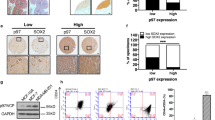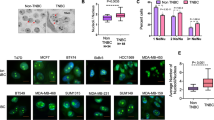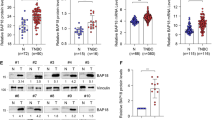Abstract
Expression of β-crystallin B2 (CRYβB2) is elevated in African American (AA) breast tumors. The underlying mechanisms of CRYβB2-induced malignancy and the association of CRYβB2 protein expression with survival have not yet been described. Here, we report that the expression of CRYβB2 in breast cancer cells increases stemness, growth, and metastasis. Transcriptomics data revealed that CRYβB2 upregulates genes that are functionally associated with unfolded protein response, oxidative phosphorylation, and DNA repair, while down-regulating genes related to apoptosis. CRYβB2 in tumors promotes de-differentiation, an increase in mesenchymal markers and cancer-associated fibroblasts, and enlargement of nucleoli. Proteome microarrays identified a direct interaction between CRYβB2 and the nucleolar protein, nucleolin. CRYβB2 induces nucleolin, leading to the activation of AKT and EGFR signaling. CRISPR studies revealed a dependency on nucleolin for the pro-tumorigenic effects of CRYβB2. Triple-negative breast cancer (TNBC) xenografts with upregulated CRYβB2 are distinctively sensitive to the nucleolin aptamer, AS-1411. Lastly, in AA patients, higher levels of nucleolar CRYβB2 in primary TNBC correlates with decreased survival. In summary, CRYβB2 is upregulated in breast tumors of AA patients and induces oncogenic alterations consistent with an aggressive cancer phenotype. CRYβB2 increases sensitivity to nucleolin inhibitors and may promote breast cancer disparity.
This is a preview of subscription content, access via your institution
Access options
Subscribe to this journal
Receive 50 print issues and online access
$259.00 per year
only $5.18 per issue
Buy this article
- Purchase on Springer Link
- Instant access to full article PDF
Prices may be subject to local taxes which are calculated during checkout






Similar content being viewed by others
References
Menashe I, Anderson WF, Jatoi I, Rosenberg PS. Underlying causes of the black-white racial disparity in breast cancer mortality: a population-based analysis. J Natl Cancer Inst. 2009;101:993–1000.
Dietze EC, Sistrunk C, Miranda-Carboni G, O’Regan R, Seewaldt VL. Triple-negative breast cancer in African-American women: disparities versus biology. Nat Rev Cancer. 2015;15:248–54.
DeSantis CE, Fedewa SA, Goding Sauer A, Kramer JL, Smith RA, Jemal A. Breast cancer statistics, 2015: convergence of incidence rates between black and white women. CA: Cancer J Clin. 2016;66:31–42.
Bauer KR, Brown M, Cress RD, Parise CA, Caggiano V. Descriptive analysis of estrogen receptor (ER)-negative, progesterone receptor (PR)-negative, and HER2-negative invasive breast cancer, the so-called triple-negative phenotype: a population-based study from the California cancer Registry. Cancer. 2007;109:1721–8.
Cho B, Han Y, Lian M, Colditz GA, Weber JD, Ma C, et al. Evaluation of racial/ethnic differences in treatment and mortality among women with triple-negative breast cancer. JAMA Oncology. 2021;7:1016–23.
Field LA, Love B, Deyarmin B, Hooke JA, Shriver CD, Ellsworth RE. Identification of differentially expressed genes in breast tumors from African American compared with Caucasian women. Cancer. 2012;118:1334–44.
Martin DN, Boersma BJ, Yi M, Reimers M, Howe TM, Yfantis HG, et al. Differences in the tumor microenvironment between African-American and European-American breast cancer patients. PLoS One. 2009;4:e4531.
Wallace TA, Prueitt RL, Yi M, Howe TM, Gillespie JW, Yfantis HG, et al. Tumor immunobiological differences in prostate cancer between African-American and European-American men. Cancer Res. 2008;68:927–36.
Jovov B, Araujo-Perez F, Sigel CS, Stratford JK, McCoy AN, Yeh JJ, et al. Differential gene expression between African American and European American colorectal cancer patients. PLoS One. 2012;7:e30168.
Barrow MA, Martin ME, Coffey A, Andrews PL, Jones GS, Reaves DK, et al. A functional role for the cancer disparity-linked genes, CRYbetaB2 and CRYbetaB2P1, in the promotion of breast cancer. Breast cancer Res: BCR. 2019;21:105.
Graw J. Genetics of crystallins: cataract and beyond. Exp Eye Res. 2009;88:173–89.
Anders F, Teister J, Liu A, Funke S, Grus FH, Thanos S, et al. Intravitreal injection of beta-crystallin B2 improves retinal ganglion cell survival in an experimental animal model of glaucoma. PLoS One. 2017;12:e0175451.
Liedtke T, Schwamborn JC, Schroer U, Thanos S. Elongation of axons during regeneration involves retinal crystallin beta b2 (crybb2). Mol Cell Proteom: MCP. 2007;6:895–907.
Gao Q, Sun LL, Xiang FF, Gao L, Jia Y, Zhang JR, et al. Crybb2 deficiency impairs fertility in female mice. Biochemical Biophysical Res Commun. 2014;453:37–42.
Sturtz LA, Melley J, Mamula K, Shriver CD, Ellsworth RE. Outcome disparities in African American women with triple negative breast cancer: a comparison of epidemiological and molecular factors between African American and Caucasian women with triple negative breast cancer. BMC cancer. 2014;14:62.
Dawson PJ, Wolman SR, Tait L, Heppner GH, Miller FR. MCF10AT: a model for the evolution of cancer from proliferative breast disease. Am J Pathol. 1996;148:313–9.
Miller FR, Santner SJ, Tait L, Dawson PJ. MCF10DCIS.com xenograft model of human comedo ductal carcinoma in situ. J Natl Cancer Inst. 2000;92:1185–6.
Pastushenko I, Brisebarre A, Sifrim A, Fioramonti M, Revenco T, Boumahdi S, et al. Identification of the tumour transition states occurring during EMT. Nature. 2018;556:463–8.
Paulucci DJ, Sfakianos JP, Skanderup AJ, Kan K, Tsao CK, Galsky MD, et al. Genomic differences between black and white patients implicate a distinct immune response to papillary renal cell carcinoma. Oncotarget. 2017;8:5196–205.
Schmidt EK, Clavarino G, Ceppi M, Pierre P. SUnSET, a nonradioactive method to monitor protein synthesis. Nat Methods. 2009;6:275–7.
Bugler B, Caizergues-Ferrer M, Bouche G, Bourbon H, Amalric F. Detection and localization of a class of proteins immunologically related to a 100-kDa nucleolar protein. Eur J Biochem. 1982;128:475–80.
Konishi H, Mohseni M, Tamaki A, Garay JP, Croessmann S, Karnan S, et al. Mutation of a single allele of the cancer susceptibility gene BRCA1 leads to genomic instability in human breast epithelial cells. Proc Natl Acad Sci USA. 2011;108:17773–8.
Tu Z, Aird KM, Zhang R. RAS, cellular senescence and transformation: the BRCA1 DNA repair pathway at the crossroads. Small GTPases. 2012;3:163–7.
Chen Z, Xu X. Roles of nucleolin. Focus on cancer and anti-cancer therapy. Saudi Med J. 2016;37:1312–8.
Yang A, Shi G, Zhou C, Lu R, Li H, Sun L, et al. Nucleolin maintains embryonic stem cell self-renewal by suppression of p53 protein-dependent pathway. J Biol Chem. 2011;286:43370–82.
Mahotka C, Bhatia S, Kollet J, Grinstein E. Nucleolin promotes execution of the hematopoietic stem cell gene expression program. Leukemia. 2018;32:1865–8.
Fonseca NA, Rodrigues AS, Rodrigues-Santos P, Alves V, Gregorio AC, Valerio-Fernandes A, et al. Nucleolin overexpression in breast cancer cell sub-populations with different stem-like phenotype enables targeted intracellular delivery of synergistic drug combination. Biomaterials. 2015;69:76–88.
Churpek JE, Walsh T, Zheng Y, Moton Z, Thornton AM, Lee MK, et al. Inherited predisposition to breast cancer among African American women. Breast cancer Res Treat. 2015;149:31–39.
Atchley DP, Albarracin CT, Lopez A, Valero V, Amos CI, Gonzalez-Angulo AM, et al. Clinical and pathologic characteristics of patients with BRCA-positive and BRCA-negative breast cancer. J Clin Oncol: Off J Am Soc Clin Oncol. 2008;26:4282–8.
Hanahan D, Weinberg RA. The hallmarks of cancer. Cell. 2000;100:57–70.
Gieniec KA, Butler LM, Worthley DL, Woods SL. Cancer-associated fibroblasts-heroes or villains? Br J Cancer. 2019;121:293–302.
Li L, Fan DB, Zhao YT, Li Y, Kong DQ, Cai FF, et al. Two novel mutations identified in ADCC families impair crystallin protein distribution and induce apoptosis in human lens epithelial cells. Sci Rep. 2017;7:17848.
Lv Y, Zhang K, Gao H. Paip1, an effective stimulator of translation initiation, is targeted by WWP2 for ubiquitination and degradation. Mol Cell Biol. 2014;34:4513–22.
Alvandi F, Kwitkowski VE, Ko CW, Rothmann MD, Ricci S, Saber H, et al. U.S. food and drug administration approval summary: omacetaxine mepesuccinate as treatment for chronic myeloid leukemia. Oncologist. 2014;19:94–99.
Yakhni M, Briat A, El Guerrab A, Furtado L, Kwiatkowski F, Miot-Noirault E, et al. Homoharringtonine, an approved anti-leukemia drug, suppresses triple negative breast cancer growth through a rapid reduction of anti-apoptotic protein abundance. Am J Cancer Res. 2019;9:1043–60.
Carotenuto P, Pecoraro A, Palma G, Russo G, Russo. A therapeutic approaches targeting nucleolus in cancer. Cells 2019;8:1090.
Otake Y, Soundararajan S, Sengupta TK, Kio EA, Smith JC, Pineda-Roman M, et al. Overexpression of nucleolin in chronic lymphocytic leukemia cells induces stabilization of bcl2 mRNA. Blood. 2007;109:3069–75.
Chen CY, Gherzi R, Andersen JS, Gaietta G, Jurchott K, Royer HD, et al. Nucleolin and YB-1 are required for JNK-mediated interleukin-2 mRNA stabilization during T-cell activation. Genes Dev. 2000;14:1236–48.
Abdelmohsen K, Tominaga K, Lee EK, Srikantan S, Kang MJ, Kim MM, et al. Enhanced translation by Nucleolin via G-rich elements in coding and non-coding regions of target mRNAs. Nucleic acids Res. 2011;39:8513–30.
Shin SH, Lee GY, Lee M, Kang J, Shin HW, Chun YS, et al. Aberrant expression of CITED2 promotes prostate cancer metastasis by activating the nucleolin-AKT pathway. Nat Commun. 2018;9:4113.
Di Segni A, Farin K, Pinkas-Kramarski R. Identification of nucleolin as new ErbB receptors- interacting protein. PLoS One. 2008;3:e2310.
Xie Q, Guo X, Gu J, Zhang L, Jin H, Huang H, et al. p85alpha promotes nucleolin transcription and subsequently enhances EGFR mRNA stability and EGF-induced malignant cellular transformation. Oncotarget. 2016;7:16636–49.
Takagi M, Absalon MJ, McLure KG, Kastan MB. Regulation of p53 translation and induction after DNA damage by ribosomal protein L26 and nucleolin. Cell. 2005;123:49–63.
Zeng S, Shen WH, Liu L. Senescence and Cancer. Cancer Transl Med. 2018;4:70–74.
Yang Y, Yang C, Zhang J. C23 protein meditates bone morphogenetic protein-2-mediated EMT via up-regulation of Erk1/2 and Akt in gastric cancer. Med Oncol. 2015;32:76.
Rosenberg JE, Bambury RM, Van Allen EM, Drabkin HA, Lara PN Jr., Harzstark AL, et al. A phase II trial of AS1411 (a novel nucleolin-targeted DNA aptamer) in metastatic renal cell carcinoma. Investigational N. drugs. 2014;32:178–87.
Derenzini M, Trere D, Pession A, Montanaro L, Sirri V, Ochs RL. Nucleolar function and size in cancer cells. Am J Pathol. 1998;152:1291–7.
Derenzini M, Nardi F, Farabegoli F, Ottinetti A, Roncaroli F, Bussolati G. Distribution of silver-stained interphase nucleolar organizer regions as a parameter to distinguish neoplastic from nonneoplastic reactive cells in human effusions. Acta cytologica. 1989;33:491–8.
Shipitsin M, Campbell LL, Argani P, Weremowicz S, Bloushtain-Qimron N, Yao J, et al. Molecular definition of breast tumor heterogeneity. Cancer Cell. 2007;11:259–73.
Merino VF, Nguyen N, Jin K, Sadik H, Cho S, Korangath P, et al. Combined treatment with epigenetic, differentiating, and chemotherapeutic agents cooperatively targets tumor-initiating cells in triple-negative breast cancer. Cancer Res. 2016;76:2013–24.
Pomper MG, Hammond H, Yu X, Ye Z, Foss CA, Lin DD, et al. Serial imaging of human embryonic stem-cell engraftment and teratoma formation in live mouse models. Cell Res. 2009;19:370–9.
Foss CA, Kulik L, Ordonez AA, Jain SK, Michael Holers V, Thurman JM, et al. SPECT/CT Imaging of Mycobacterium tuberculosis Infection with [(125)I]anti-C3d mAb. Mol Imaging Biol. 2019;21:473–81.
Acknowledgements
This work was funded by the DOD BCRP Center of Excellence Grant W81XWH-04-1-0595 to S.S, DOD BCRP, W81XWH-15-1-0017 to V.M and the Division of Nuclear Medicine and Molecular Imaging.
Author information
Authors and Affiliations
Contributions
Conception and experimental design: Y.Y., V.M. and S.S. Performed the experiments: Y.Y., A.N., V.M., S.C., Z.C., G.W., B.W., A.L., M.B., H.S. and H.Y., Acquisition of data: V.M., S.C., J.L., H. Z., T.H., K.G., L.C., E.G. and S.S. Analysis and interpretation of data: V.M., S.C., L.C., J.L., H.Z., K.G., S.A., M.P. and S.S. Writing and/or revision of the manuscript: Y.Y., S.A., V.M., M.P. and S.S. Study supervision: V.M., M.P. and S.S. GEO accession number: GSE137916.
Corresponding authors
Ethics declarations
Competing interests
The authors declare no competing interests.
Additional information
Publisher’s note Springer Nature remains neutral with regard to jurisdictional claims in published maps and institutional affiliations.
Rights and permissions
About this article
Cite this article
Yan, Y., Narayan, A., Cho, S. et al. CRYβB2 enhances tumorigenesis through upregulation of nucleolin in triple negative breast cancer. Oncogene 40, 5752–5763 (2021). https://doi.org/10.1038/s41388-021-01975-3
Received:
Revised:
Accepted:
Published:
Issue Date:
DOI: https://doi.org/10.1038/s41388-021-01975-3



